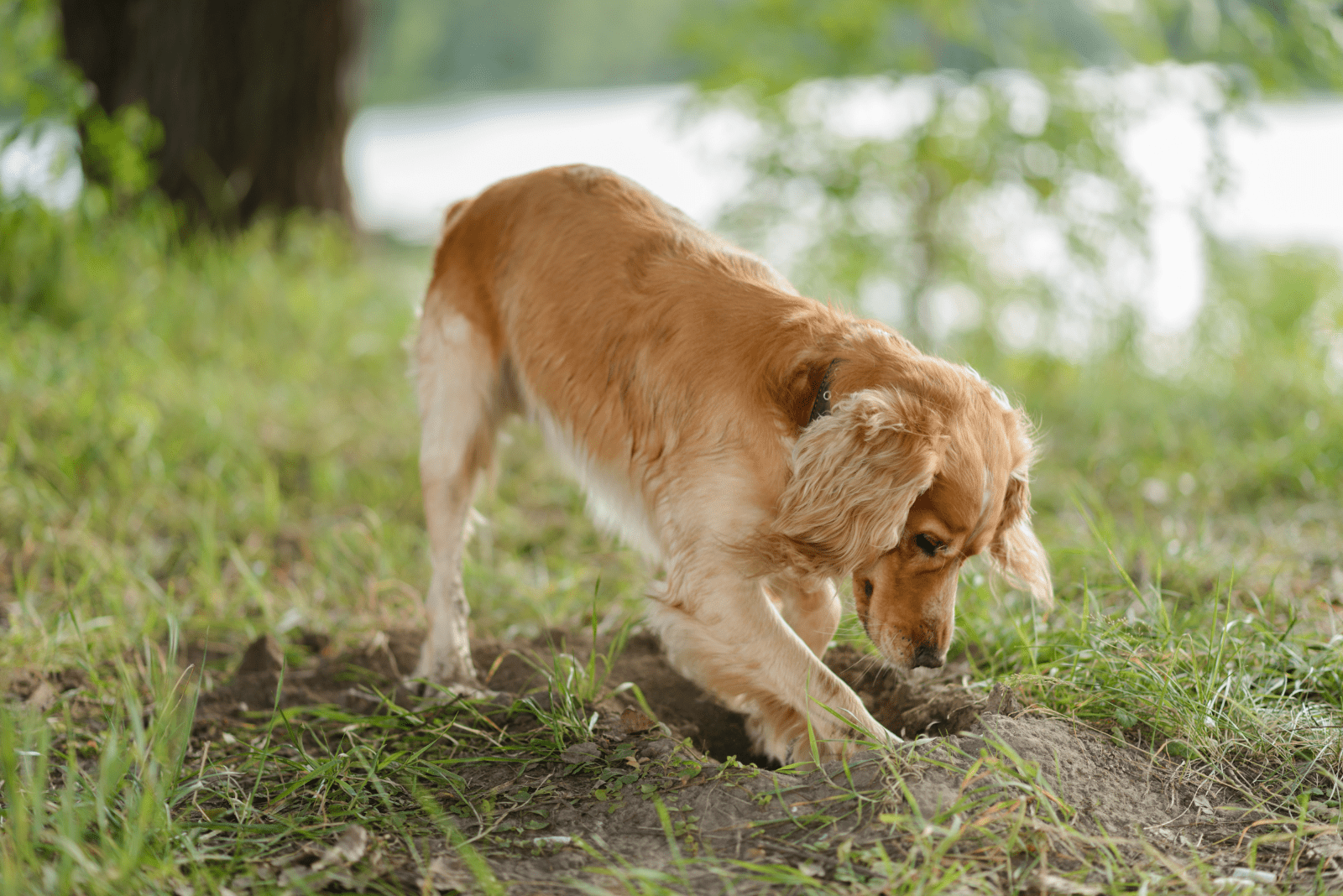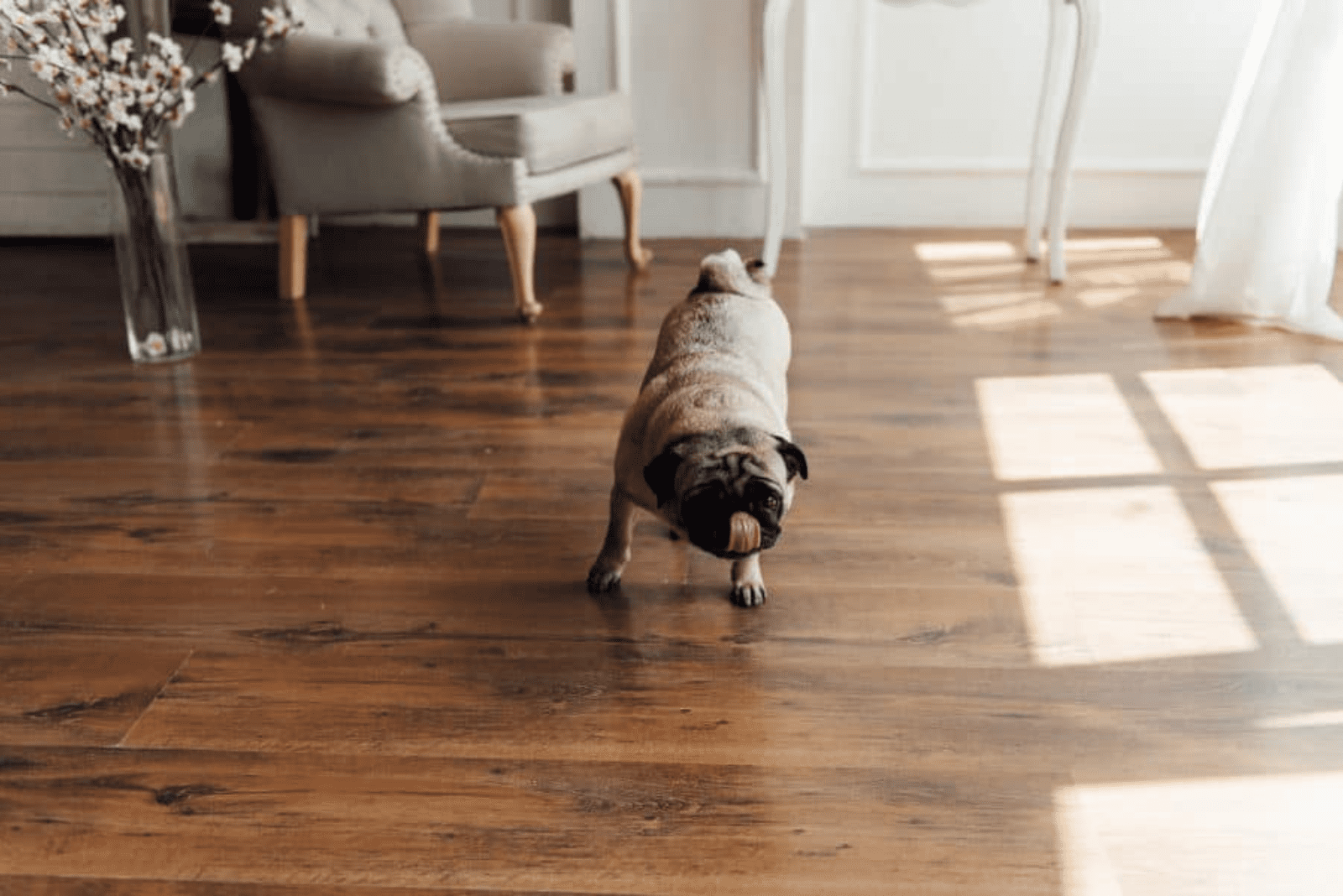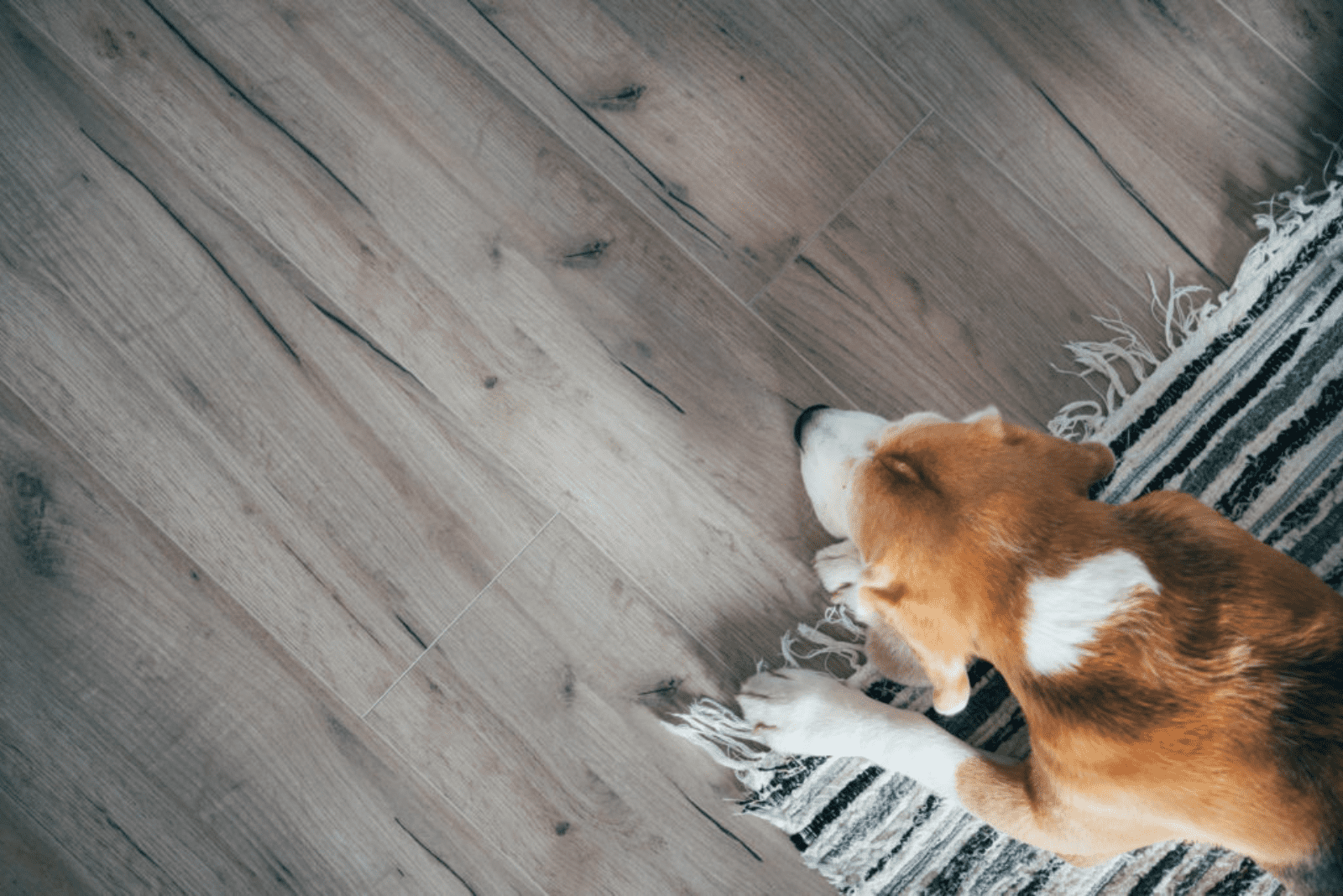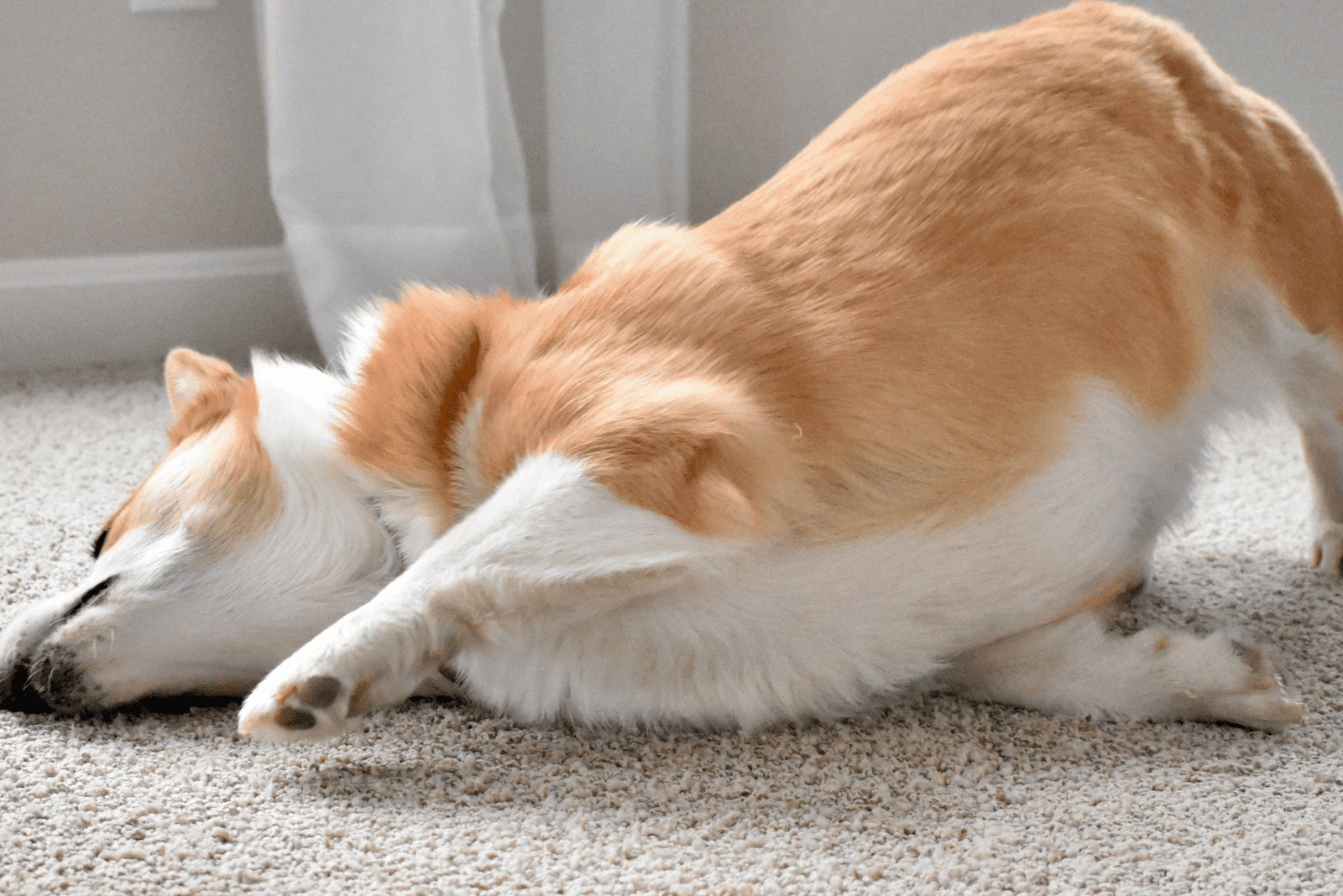No matter which breed of dog you have, you have certainly wondered “Why does my dog scratch the hell out of those beautiful hardwood floors?” I will give you some pointers on their reasoning behind this dog behavior. Be warned — your dog might just be a carving artist.
Dog’s paws are an immense tool for destroying furniture too, so whether vertical or horizontal, scratching behavior will be part of your life in some capacity. Alright, answers to why do dogs scratch the floor incoming.
Why Does My Dog Scratch The Floor? Open Your Third Eye
Prepare your brain for some mind bending revelations about this behavior. There will be things you never considered, or maybe you knew the cause but could never find a working solution. Do not fear! Advice and possible solutions are included for no additional cost.
1. Dig A Hole To Stay Warm

If you ever caught an episode of a wolf-related show on National Geographic, you must have seen that wolf puppies always emerge from some giant, hollow tree log or an underground den.
The purpose of the dwelling under the surface is to provide shelter from cold, heat, wind or other animals. They build quite fancy tunnels underground to enable fresh air to circulate throughout the den. That is how wild dogs work.
Your dog still shares 98.8% DNA with a wolf, so digging a hole to cool itself or stay warm is completely natural. This often happens when the dog does not have its own bed or designated spot with adequate temperature control.
If you identified this as the issue at hand, my advice would be to get a bed with a tall lip that can keep the dog’s body heat trapped within itself. Do not go looking for castle walls because pooches like to be aware of their surroundings.
2. See These Scratches? That’s My Zone
I always admired people who sit somewhere in the house and feel instantly comfortable right then and there. I always had to wiggle my behind or do something with the angle of sitting to feel cushy.
Your dog might be the same — a comfortable place is one where you feel at home. To make it more homey, they scratch the floor and create some ritualistic signs that cleanse the floor of negative energy.
Oftentimes, after scratching, the dog will circle around the spot on the floor before lying down. Scientists believe this is an inherited trait that is caused by the dog’s instinct to find the optimal spot for getting ready to defend itself from invaders. Got to protect that sleeping area.
This behavior can happen on beds and couches too. Dogs usually prefer to have some kind of contour around their “hole”. You might catch your dog making its own bed on your bed. That can result in some new holey pattern on your brand new bed sheets or covers.
Again, a dog bed with raised edges and some cushion on the bottom will make sleeping and resting a much more enjoyable experience for your dog which will hopefully reduce their woodworking action.
3. Your Dog Feels All The Unspent Energy
A dog’s digging behavior will often be a show of pent up energy. Pet owners who lead a busy life and have a very high energy dog breed are bound to see some destructive behavior like ground scratching.
Dog breeds that require a lot of physical activity but do not get enough exercise can become the ruin of many a poor floor. Lying around all day and walking on a leash is good relaxation, but the excess energy calls for sprinting, jumping, tug of war and other intensive workouts.
If your dog has a solid food drive, you will easily get them to do anything for some treats. For the smarter dogs that know full restaurant service is non-negotiable, prey drive will most likely work. I dare say that with great prey drive come great acrobatic performances and energy release.
Establishing a good dog training routine while it is a puppy is an effective way to instill good house habits. A puppy that has been trained and used to plenty of exercise will always look forward to it.
The expectation of physical activity alone can keep them focused on it instead of digging through floors. For those who have demanding jobs that keep them away from their companions, here is an article on how to keep a dog entertained while at work.
4. I Missed You So Much That I Did Some Renovation

Oh boy will this one be lengthy. Where do I start? The story always begins with puppy selection. Certain dog breeds, especially miniature and toy sized dogs, are more fragile and they know it.
To compensate for the size, they will often snarl, growl, show teeth or even attack in situations that exacerbate their insecurity. These dogs become attached to and dependent on their dog owners in an unhealthy way.
Everyone knows that this is textbook separation anxiety. It can be set off by the process associated with leaving the house such as getting dressed or putting on your shoes. The separation anxiety can also kick in after you leave the house.
The post-leaving apocalypse usually happens when you punish the dog for its anxiety while leaving the house. Negative reinforcement will never put a stop to this kind of behavior. It will most likely make it worse.
The dog will have many triggers with this negative experience of “abandonment” that can include anything: keys jangling, phrases you say before leaving, your demeanor or energy and many more.
It is quite obvious that a dog scratching the floor is one of the better scenarios you can imagine when it comes to separation anxiety. Here is a list. This list should help you get results.
1. Set A Routine That Encourages Self-Comfort In Your Dog
Routines are important for us humans too, and dogs are no different. If taught a specific set of actions that result in positive reinforcement, your dog will learn to be self-sufficient in terms of company.
First of all, you will need to create a calm and easily anticipated process before leaving the house. The routine should be based on teaching the dog when it should anticipate your attention. Equally important is getting your dog to understand and predict when it will not get attention.
Having some fun and exercise at the same time before leaving the house will help your dog get rid of the excess energy so that the body makes the mind feel more at ease. Sleeping and resting will naturally occur once you leave since there is no activity.
This way of “programming” your dog to behave according to what is going on (or not going on) around it is easier than you think. You might even enjoy the process, since it will create a stronger relationship between you two.
2. Passive Stimuli When You Are Not Around
Do not simply throw down a bunch of toys expecting your dog to play with them while you are not present. The toys need to be engaging because dogs get bored easily with things that do not tickle their fancy.
Make sure you provide it with enough attention and physical activity so that the dog becomes tired and even disinterested in having all the attention. This will automatically trigger a “rest mode” once you leave.
I do not recommend interactive food dispensers because a dog should always expect you to be in charge of feeding it, not the plastic thing that whirs. No matter how complex the feeding puzzle is, the dog will eventually find a way to exploit it. Obesity is bad!
3. When I Do This I Get A Reward

Relaxing can be hard to teach to a dog. If you ignore your pooch while it is in your presence, it will learn this bad habit of getting any kind of attention (even bad) by scratching your floor, pooping or urinating around the house etc.
Never reward your dog when it is doing something unfavorable. Wait until it calms down and stops obsessing over your attention and then reward it with treats or interaction. Keep increasing the calm period each time before you leave for work.
Do not act as if your dog does not exist when it becomes calm. It is the bad behavior that you want to ignore. Attention is the treat it gets for being calm and silent.
4. Teaching A Dog To Rest On Command
This might sound like an army boot camp, but it is quite useful once the dog learns the command. Usually, the keyword is “settle” but you can associate any word with the command. Once you see your dog understands what the word implies, it will often anticipate when to do it too.
You can start off by leading your dog to the place you want it to relax at, and reward it for staying there. Both food and attention will be great incentives for the dog to quickly understand what is being asked of it.
Clickers can help with this task too if you are not a big fan of producing confirmation sounds yourself. Saying “goodbye” to your dog should be avoided in any scenario where separation anxiety is present. It only puts your dog into a state of excitement.
5. Connect The Place With The State
While any of the methods above will eventually achieve this purpose, there are some things you can do to speed up the process of teaching your dog that a designated spot for resting is the same thing as resting. It is like a wireless charger really…
This is a very useful thing when your dog starts scratching the floor or defecating in the house when you are away or simply at the door. Every animal, and especially dogs, love their sleep/rest spot. That is where they go to do some introspection.
Dogs will rarely scratch or poop on the spot where they are in a resting state of mind. The two things simply are not associated. This is why you need to bring treats, toys, other fun stuff like voice boxes etc. in or on that place of serenity.
Luring your dog to the spot with some attention, treat or toy will be a good start. This should be done after exercising or playing with the dog. Once the energy has been spent, the dog will naturally want to relax. You need to encourage this behavior with rewards on the relaxation spot.
An alternative to ease the transition from anxious before work to relaxed can be leaving something with your odor for the dog to lie next to. This will soothe most dogs, especially puppies. Get the best bed you can to make sure it is comfortable enough for the dog to feel safe.
Getting a good dog bed does not mean getting the most expensive one. Dogs do not care about the price tag. They only want it to be a good fit for them. Sometimes they will feel amazing on a $2 blanket or an old cushion with you or your family’s scents on it.
6. Calming Pheromones For Dogs
If you have never heard about calming pheromones, this might be your saving grace. These are synthetic pheromones that can be infused into any object or material.
These work just like natural pheromones do — the dog will feel more secure and relaxed while feeling the pheromones in the air. This can be an excellent choice to help out with setting up a routine for your dog.
Bear in mind that this is not the ultimate cure. This can help your process of getting rid of separation anxiety, but might not be enough.
You can find some wall plug containers of calming pheromones on Amazon. If you prefer something that does not require electricity, then collars or toys will work well too.
I Tried All Of The Above Without Result
Well, maybe you are forgetting that separation anxiety requires structure. I am talking about a structured routine. You cannot wing it and say some words that are temporarily successful.
If your dog goes to the resting stop while you still see it, what is stopping it from reverting to anxiety once you are out of the door? You must not get irritated and angry if corrective training does not immediately work.
Patience and assertiveness are the most important things when dealing with a behavioral problem. You will have to be persistent in enforcing the rules in a positive way. You might ask “Why is my dog still destructive when left alone?” and you would be right to be frustrated.
The thing is, you might have to go out of your way to make things work. Get someone you trust to be around the dog for shorter periods of time.
It is always recommended to put an inexpensive IP camera to record what your dog does while you are away. This can help you recognize some behavioral patterns that could save you a lot of time and effort.
Other than tiring out your dog prior to leaving, you can also practice being calm and composed. Dogs communicate and understand best through body language, so they easily understand what kind of mood they have to mirror.
If you keep visualizing doomsday scenarios of your floors being dug out, the dog will sense your nervousness and will become anxious.
Ultimately, you can have a veterinarian prescribe some medication that will help the dog relax while alone. It is important to note that very serious cases of separation anxiety cause the dog to stop having any food drive or reaction to positive reinforcement other than your attention.
5. Scent Marking Is Worse Than Barking

The marking behavior is as old as the oldest canine that ever lived. This is a natural and common occurrence in all animals. Adult males are especially adept at peeing in tough to hit corners of the house. Scratching is a very popular marking behavior that bears do too.
When your dog scratches to mark a spot on the floor, there is not much you can do. Negative reinforcement is definitely a no, but I understand feeling helpless can be frustrating.
You can try training your dog to “replace” the scratching with some other activity that will spend a little bit of its energy. However, instinctual behavior such as marking is nearly impossible to prevent. Just give your dog a break.
Note: spayed/neutered dogs are less likely to mark territory. If you do not plan on having your dog mate this will be a healthier choice for both owner and dog.
Scratching The Floor Has A Secret Agent
We humans are mostly visual creatures. The majority of people will remember or know something better once it is visible. Dogs are scent creatures. Dog noses are infinitely more sensitive and advanced than ours.
How are the scratches useful for their nose then? Special glands (apocrine sweat glands) that help dogs control their body temperature produce a unique scent that is like the PID of a dog. Scratching embeds the scent deeper into the floor and it remains there for a longer period of time.
Again, this is a natural behavior that most dogs have. Dogs that are closer to wolf genetics will have stronger natural urges such as scent marking.
6. Your Dog Might Have Medical Issues
Reading your dog’s body language is key in understanding what cause lies behind the incessant floor scratching. If you notice your dog doing it regardless of exercise, attention or too often to be a marking instinct, then your pooch might be suffering from a medical condition.
Dog Dementia
Canine cognitive dysfunction syndrome commonly occurs in older dogs. The brain’s ability to remember things, learn new ones or do the basics right becomes compromised.
Ground scratching is a common symptom of a confused dog with CCD. The confused state of the dog’s mind will make it become fearful and insecure so it will try to dig in to create a shelter. There are other symptoms like mood swings, irritability, low energy, appearing lost etc.
These symptoms are often so mild that dog owners cannot even notice them. Unfortunately, there is no cure for the aging process and the symptoms will worsen with time.
Trying To Alleviate Pain
Dogs can have conditions that have no visible symptoms but cause pain. Medical conditions affecting the dog’s internal organs can often be extremely painful and cause the dog to scratch the floor in the attempt to lessen the pain.
Another reason why it would scratch the ground has to do with ancestry. A physically weakened dog needs to stay out of sight while recovering, so a hole in the ground makes sense. The scratching is often accompanied by whimpering.
A frequent condition that causes this chain of events is arthritis. Chronic pain in the joints becomes unbearable, so the dog will scratch in the attempt to get rid of the pain.
Conclusion
I hope we answered your question “Why do dogs scratch the floor question adequately. There are many possibilities when it comes to dog behavior, and visiting an animal behaviorist might be beneficial if nothing you tried worked.
Never admit defeat in these situations. Your dog will respect you more if you always keep trying. It will be good for your self-confidence too. It will take time to achieve long term results in terms of changing a dog’s bad habit.
Maybe it is not a habit but an instinct like scent marking. In that case, you should definitely explore your options with a professional.
I am certain that you will manage to curb that unwanted behavior without anyone’s help. Perhaps your dog will have to lend you a paw.
Have fun trying to change things!
Read Next: Is Your Dog Rubbing Its Face On The Carpet? — 15 Possible Reasons















